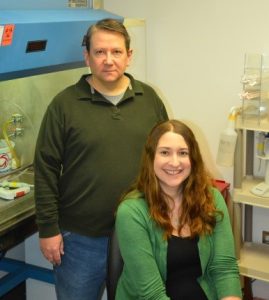Nilles, Condry publish handbook to aid study of drug-resistant bacteria
Their names are mysterious and complex; the diseases they cause are well known. Scientists call them Yersinia pestis, Escherichia coli, Salmonella, Shigella, and Pseudomonas. The diseases they cause range from the plague to pneumonia to virulent food-borne illnesses.
Most make the Top-18 list of biggest threats to the United States from drug-resistant bacteria compiled by the Centers for Disease Control and Prevention. According to the CDC, “at least 2 million people become infected with bacteria that are resistant to antibiotics and at least 23,000 people die each year as a direct result of these infections.”

The search to prevent infections from these bacteria received a boost from biomedical scientists at the School of Medicine and Health Sciences. Associate Professor Matthew L. Nilles and Assistant Professor Danielle L. Jessen Condry in the Department of Biomedical Sciences, have published a handbook or vade mecum to aid researchers in studying pathogenic bacteria.
Nilles and Jessen Condry are the editors of Type 3 Secretion Systems: Methods and Protocols. The book discusses techniques to study a method some bacteria use to infect human cells. Nilles and Jessen Condry also contributed to several chapters in the book. The book draws on contributions from scientists across Europe and the United States.
Other contributors from the UND SMHS Department of Biomedical Sciences are Associate Professor David S. Bradley and graduate students Travis D. Alvine and Peter L. Knopick. Former members of the Nilles lab also contributed chapters, including Patrick Osei-Owusu, Thomas A. Henderson, and Melody Toosky, who provided the cover art for the book.
Certain bacteria use a unique burglar’s tool to break in and enter cells; it is known as a type 3 secretion (T3S) system. T3S systems are used by pathogenic bacteria to inject toxins directly into cells to change cell behavior.
In the book, Nilles and Jessen Condry say, “Type III secretion (T3S) systems are found in a large number of gram-negative bacteria, where they function to manipulate the biology of infected hosts.”
Gram-negative refers to a result from a laboratory technique used in the identification of bacteria. The family of gram-negative bacteria includes some of the most virulent and most drug-resistant threats to humans.
“We hope to provide other researchers with a starting toolbox to initiate or advance their work on T3S systems, potentially leading to a better understanding of the roles of T3S systems in bacterial-host interactions,” Nilles said.
A free preview of the book is available at the publisher’s website.
— Denis F. MacLeod, Assistant Director, Office of Alumni and Community Relations, School of Medicine and Health Sciences, 777.2733, denis.macleod@med.UND.edu, www.med.UND.edu/
